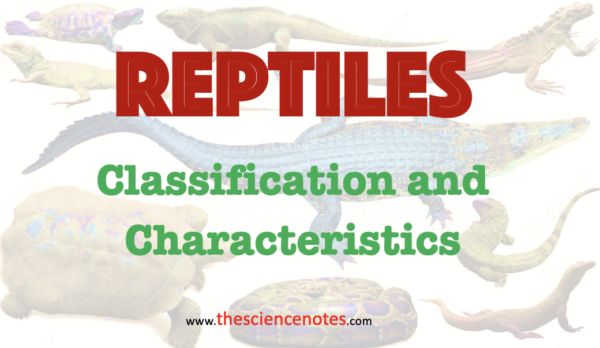What are Reptiles?
Reptiles, as defined in the class Reptilia, are a diverse group of vertebrate animals that encompass snakes, lizards, crocodiles, turtles, and tortoises. They are characterized by their air-breathing nature, cold-blooded physiology, and scaly bodies devoid of hair or feathers. A notable trait of reptiles is their tendency to lay soft-shelled eggs on land, although certain squamates like lizards, snakes, and worm-lizards exhibit viviparity, giving birth to live young. With internal fertilization, amniotic development, and epidermal scales providing bodily coverage, reptiles have adapted to various habitats and play vital roles in ecosystems. Nile crocodiles (Crocodylus niloticus) and common king snakes are examples of reptile species found in this diverse class.
Taxonomic Classification of Reptiles
Kingdom: Animalia (Animals)
Phylum: Chordata (Chordates)
Subphylum: Vertebrata (Vertebrates)
Class: Reptilia (Reptiles)

Characteristics of Reptiles
- Creeping and burrowing terrestrial animals with scales on their body.
- Cold-blooded animals found in most of the warmer regions of the world. Cold-blooded animals relying on external heat sources.
- Dry and rough skin without any glands. Scales or scutes protect the body, aid in movement, and retain moisture.
- Body divided into head, neck, trunk, and tail.
- Some reptiles shed their scales as skin cast.
- Respiration takes place with the help of lungs.
- Monocondylic skull.
- Limbs may or may not be present. If present, they are two pairs of pentadactyl limbs with claws. Snakes do not have limbs.
- Three-chambered heart, except for crocodiles which have a four-chambered heart.
- Well-developed nervous system with 12 pairs of cranial nerves.
- No external ear openings, but a structure called the tympanum represents the ear.
- Possess a cloaca, a common opening for excretion and reproduction.
- Generally uricotelic, excreting nitrogenous waste as uric acid.
- Internal fertilization.
- Oviparous, laying shelled eggs. Eggs are often yolky, providing nutrients for the developing embryo. Some are ovoviviparous or viviparous.
- Examples of reptiles include snakes, turtles, lizards, and crocodiles.
- Diverse behavior, morphology, and reproductive strategies.
Classification of Reptiles
Reptiles, belonging to the class Reptilia, are classified into three major subclasses: Anapsida, Parapsida, and Diapsida. Each subclass has distinct characteristics and includes different groups.
1. Anapsida:
The Anapsida subclass is characterized by a skull with a complete roof formed by dermal bones and no temporal fossae. It is further divided into two groups: Cotylosauria and Chelonia.
- Cotylosauria: This group consists of ancient reptiles that existed in the Paleozoic era but are now extinct.
- Chelonia: This group includes modern chelonians, such as turtles, tortoises, and terrapins. Chelonians are classified based on the method of retracting their heads into their shells.
2. Parapsida:
Reptiles belonging to the Parapsida subclass have a skull with a single temporal fossa located high up on the skull. Some reptiles that fall under this subclass include Protosaurs, Nothosaurs, and Placodonts. Two major groups within Parapsida are Ichthyosaurs and Plesiosaurus, which became extinct at the end of the Cretaceous period along with dinosaurs.
3. Diapsida:
The Diapsida subclass is characterized by a skull with two temporal vacuities or openings on each side. It is the most diverse group of reptiles and includes various reptilian orders. Diapsida is further divided into two major groups: Archosauria and Lepidosauria.
- Archosauria: This group includes dinosaurs and pterosaurs. Crocodilus and Chameleon are examples of reptiles within Archosauria.
- Lepidosauria: This group includes lizards and snakes. It is one of the largest orders of reptiles, with a wide range of sizes and species diversity.
In addition to the subclasses, there are four main types:
- Turtles: Turtles have a protective shell composed of scutes and bone. They can retract their heads and are further classified as tortoises (land-dwelling) and terrapins (freshwater-dwelling).
- Squamata: This group consists of lizards and snakes. It is one of the largest and most diverse orders of reptiles, ranging in size from tiny geckos to large snakes like the green anaconda.
- Crocodilian: Crocodiles and alligators belong to this group. They are large, semi-aquatic predators with a solidly built body, long flattened snouts, and a laterally compressed tail.
- Tuatara: The tuatara is a lizard-like reptile found in New Zealand. It is the only surviving member of its order, Sphenodontia. Tuataras have distinct features such as biconcave vertebrae, a rudimentary diapsid skull, and a third eye on their forehead.
The classification of reptiles is based on various anatomical and morphological characteristics, including skull structure, presence or absence of temporal fossae, and other skeletal features. This classification helps in understanding the diversity and evolutionary relationships among different reptilian species.